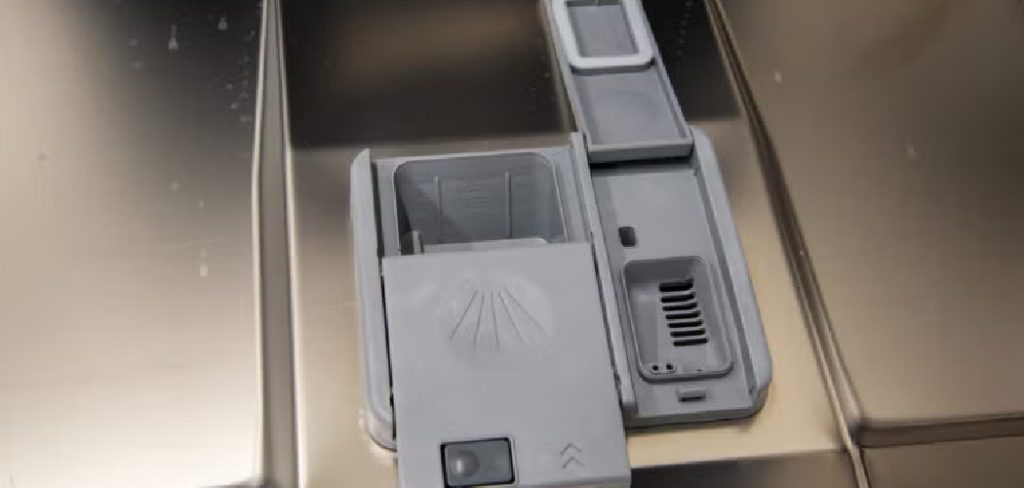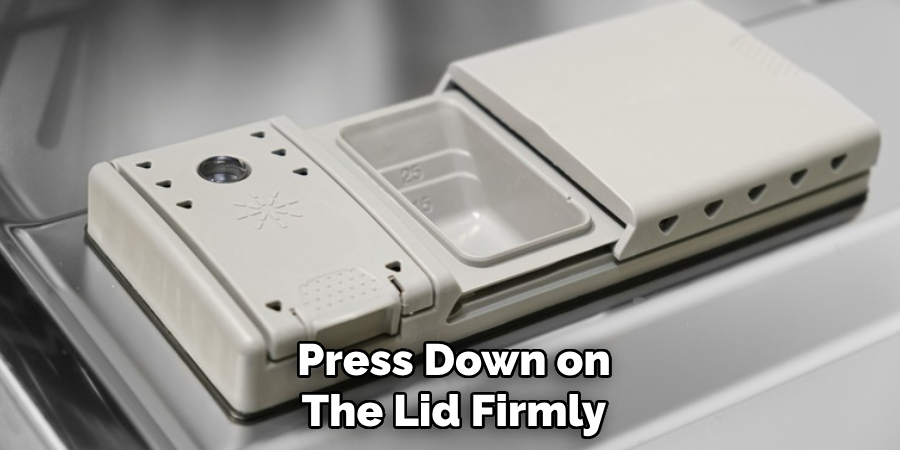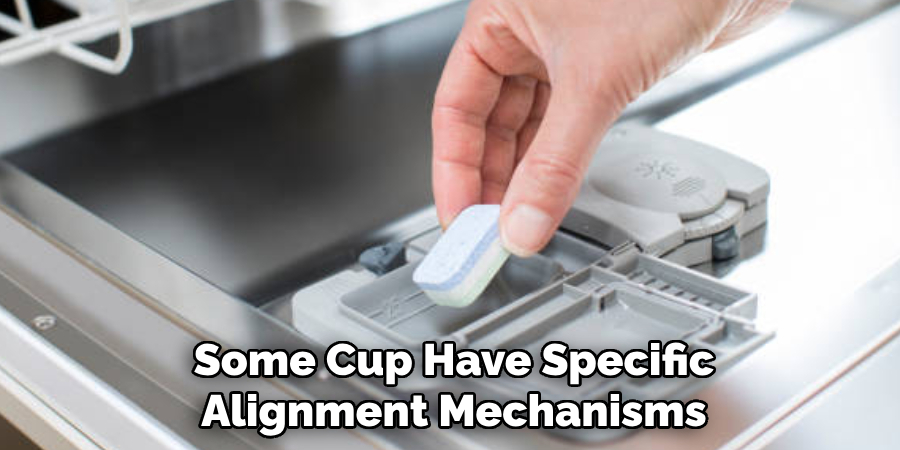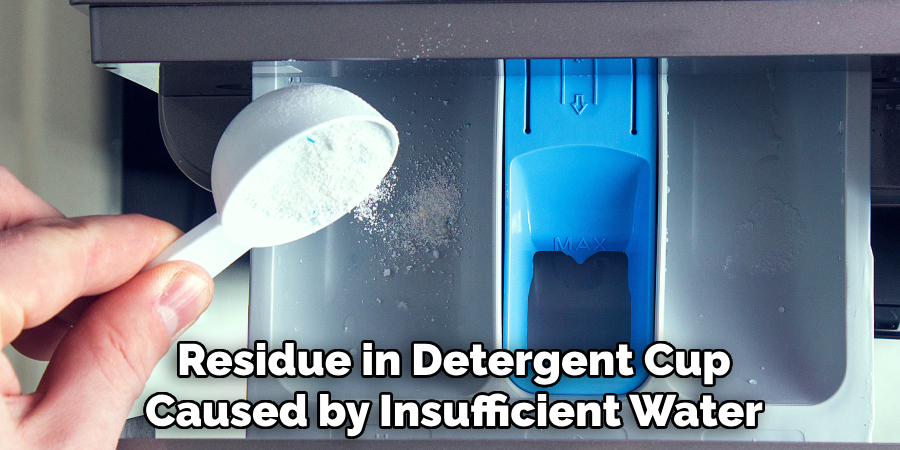The detergent cup in your dishwasher plays a crucial role in ensuring your dishes come out clean and spotless. Knowing how to properly close the detergent cup is essential for the appliance to function effectively. This guide will walk you through how to close dishwasher detergent cup, helping you achieve optimal cleaning results every time.

The Role of the Detergent Cup
The detergent cup is designed to release dishwashing detergent at the optimal time during the cleaning cycle. By securely holding the detergent until it is needed, the cup ensures that the detergent is dispersed evenly, maximizing its ability to break down grease, stains, and food residue. A properly functioning detergent cup contributes to the overall efficiency of the dishwasher, preventing wastage of detergent and promoting spotless, hygienic results. Understanding its role highlights why it is important to ensure the cup is closed securely before starting the dishwasher.
Identifying Your Dishwasher Detergent Cup Type
Dishwasher detergent cups come in various designs depending on the make and model of your appliance. The most common types include flip-top cups, sliding lids, and push-to-close compartments. Flip-top cups have a hinged lid that you can open and close manually, while sliding lids typically require you to push or slide them to secure the detergent in place. Push-to-close compartments often feature a spring mechanism that clicks into position when pressed. Checking your dishwasher’s user manual can help you identify the exact type of detergent cup your model uses, ensuring proper handling for optimal performance.
10 Methods How to Close Dishwasher Detergent Cup
1. Press Firmly Until You Hear a Click
Many dishwasher detergent cups are designed with a latch mechanism that produces a clicking sound when secured properly. After filling the detergent cup with the recommended amount of detergent, press down on the lid firmly until you hear a distinct click. This sound is an indication that the latch has engaged correctly, ensuring the detergent remains contained until the appropriate phase of the washing cycle.

2. Ensure Proper Detergent Placement
Overfilling the detergent cup can interfere with its ability to close properly. If there is an excessive amount of detergent, the lid may not shut securely, causing it to pop open prematurely. It is essential to follow the manufacturer’s recommended detergent amount and distribute it evenly within the compartment to prevent overflow. If using liquid detergent, avoid overfilling to prevent spillage that may hinder the latch mechanism from closing correctly.
3. Check for Obstructions
A detergent cup may fail to close properly if food particles, soap residue, or debris obstruct the latch. Before attempting to close the cup, inspect the surrounding area and the latch for any visible blockages. Wipe away any buildup using a damp cloth or a soft brush. Ensuring a clear and clean latch area will allow the cup to close smoothly and function as intended.
4. Align the Lid Correctly
Certain detergent cups have specific alignment mechanisms that must be positioned accurately before the lid can close properly. Misalignment of the lid with the locking mechanism may prevent the cup from staying shut. Carefully examine how the lid is supposed to fit and make sure it aligns precisely with the latch before pressing it down. If the lid feels slightly off track, reposition it until it sits correctly within the designated grooves.

5. Apply Gentle Pressure with a Flat Object
For detergent cups that require extra force to secure the latch, applying even pressure with a flat object, such as the back of a spoon or a butter knife, can be helpful. Pressing down with a broader surface helps distribute pressure evenly across the lid, ensuring that it locks into place without requiring excessive force. However, be careful not to apply too much pressure to avoid damaging the latch mechanism.
6. Warm Up the Lid in Case of Stiffness
In cold environments, plastic parts of the dishwasher detergent cup may become rigid, making it difficult to close properly. If the lid feels stiff or unyielding, try running warm water over it for a few seconds. This will make the plastic more pliable, allowing it to latch more easily. This method is particularly useful for dishwashers that have not been used in a while or are exposed to colder temperatures.
7. Lubricate the Latch Mechanism
If the detergent cup’s latch is sticking or becoming difficult to close, applying a small amount of food-safe lubricant can help. A drop of vegetable oil, silicone grease, or a similar lubricant can be applied sparingly to the latch area. This will reduce friction and improve movement, making it easier to close the cup securely. Ensure that only a minimal amount of lubricant is used to avoid any potential contamination of the dishwasher’s internal components.
8. Inspect and Replace a Broken Latch
With continuous use, the latch mechanism on a detergent cup may wear out or break. If the detergent cup consistently fails to close despite following the previous steps, inspect the latch closely for signs of cracks, warping, or other damage. If the latch is broken, it will need to be replaced. Most dishwasher manufacturers offer replacement parts that can be easily installed to restore proper functionality.

9. Adjust the Dishwasher Door
A misaligned dishwasher door can create pressure on the detergent cup, preventing it from closing securely. If you notice resistance when trying to close the detergent cup, check that the dishwasher door aligns correctly with the frame. If necessary, adjust the hinges or tighten any loose screws to ensure that the door closes evenly. A well-aligned door reduces stress on the detergent cup and ensures smooth operation.
10. Use an Alternative Detergent Dispenser
If the detergent cup is completely broken and cannot be replaced immediately, an alternative method of dispensing detergent can be used. Some dishwashers allow detergent to be placed directly into the bottom of the machine, where it will dissolve naturally during the wash cycle. However, this method should only be used after consulting your dishwasher’s user manual to ensure compatibility. While not an ideal long-term solution, this approach can serve as a temporary workaround until the detergent cup is repaired or replaced.
Troubleshooting Common Issues
Even with proper care and maintenance, you may occasionally encounter problems with your dishwasher detergent cup. Below are some common issues and their potential solutions:
1. The Detergent Cup Does Not Open During the Cycle
If the detergent cup remains closed after a wash cycle, it could be caused by a faulty spring mechanism or a blocked dispenser door. First, ensure that no dishes or utensils are obstructing the detergent cup’s door. If there is no visible obstruction, check the spring mechanism for signs of wear or damage, and replace it if necessary. Additionally, inspect the dishwasher’s timer or control panel, as a malfunction here could also prevent the cup from opening at the correct time.
2. Detergent Leaks Out Prematurely
If detergent spills out of the cup before the wash cycle begins, improper latching or overfilling may be the culprit. Double-check that the cup is securely latched using one of the methods outlined above. Ensure that you are not exceeding the recommended detergent amount, as this can cause overflow. For liquid detergents, consider switching to detergent pods or powder to minimize leakage.
3. Detergent Residue Remains After the Cycle
Residue in the detergent cup is often caused by insufficient water pressure or a clog in the spray arms. Inspect the spray arms for blockages such as food particles or mineral deposits, and clean them thoroughly. Additionally, ensure that the water inlet valve is supplying adequate pressure. If the problem persists, check for hard water buildup in the dishwasher and consider using a water-softening detergent or a rinse aid to improve performance.

4. Cup Lid is Difficult to Open or Close
Stiff or stuck lids can occur due to soap buildup, debris, or damaged components. Clean the detergent cup and its latch mechanism thoroughly with warm, soapy water and a soft cloth. If the lid remains difficult to operate, inspect for damage to the latch or hinges. Applying a small amount of food-safe lubricant, as described earlier, can also help improve functionality.
5. The Detergent Cup is Completely Broken
If the detergent cup is cracked, warped, or otherwise unusable, it will need to be replaced. Refer to your dishwasher’s user manual to find the correct replacement part and follow the manufacturer’s guidelines for installation. Alternatively, contact a professional technician for assistance. Until the cup is replaced, you can use the alternative detergent dispensing method outlined earlier for temporary use.
By following these troubleshooting steps, many common detergent cup issues can be resolved, restoring your dishwasher’s efficiency and performance. If problems persist, professional repair services may be required to address more complex malfunctions.
Conclusion
Properly closing the dishwasher detergent cup is essential to ensure effective dishwashing and optimal detergent dispersion. By following these ten methods, you can troubleshoot and resolve issues related to the detergent cup not closing properly. Regular maintenance, careful detergent placement, and inspecting the latch for signs of wear will contribute to the efficient functioning of your dishwasher. So, there you have it – a quick and easy guide on how to close dishwasher detergent cup.
Professional Focus
Angela Ervin, a former interior designer turned blogger, specializes in kitchen design and renovations. Through her website, she blends her passion for cooking with design expertise, sharing practical and creative ideas. Known for balancing functionality and beauty, Angela’s insightful content has made her a trusted voice in home design and lifestyle.
About the Author
Angela Ervin, an experienced interior designer and blogger, combines her passion for kitchen renovations with storytelling. Living in Petersburg with her family, she enjoys cooking and testing her projects firsthand. Known for her humor and relatable style, Angela shares creative, functional design insights through her content, making her a trusted voice in home design.
Education History
University: Virginia Commonwealth University
Degree: Bachelor of Fine Arts (BFA) in Interior Design
- Angela’s education at VCU focused on mastering core interior design principles, including spatial planning, color theory, materials selection, and sustainable design practices.
- She gained hands-on experience through studio projects and collaborative design exercises, which honed her ability to create functional and aesthetically pleasing environments.
- Her coursework also emphasized problem-solving and practical applications of design, preparing her for real-world projects like her self-directed kitchen renovations.
- The program’s strong foundation in both technical skills and creative expression shaped Angela’s ability to seamlessly integrate form and function in her work.
